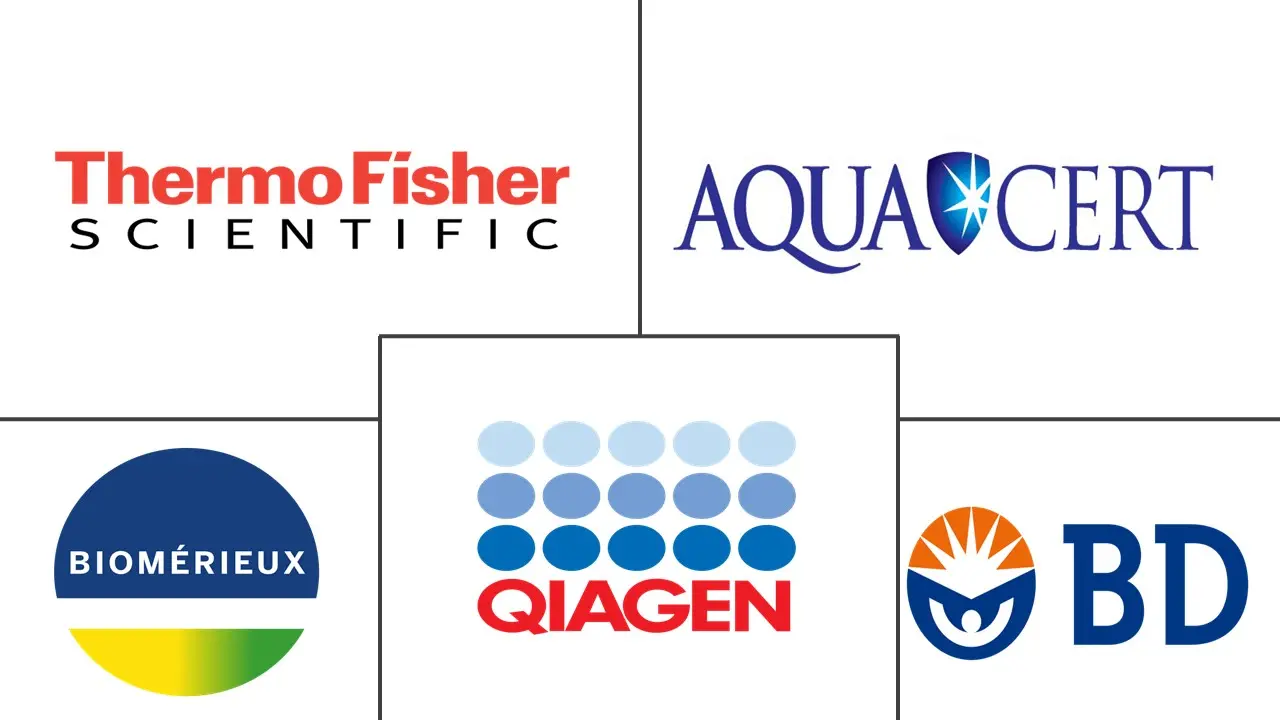Legionella Testing Market Size and Share
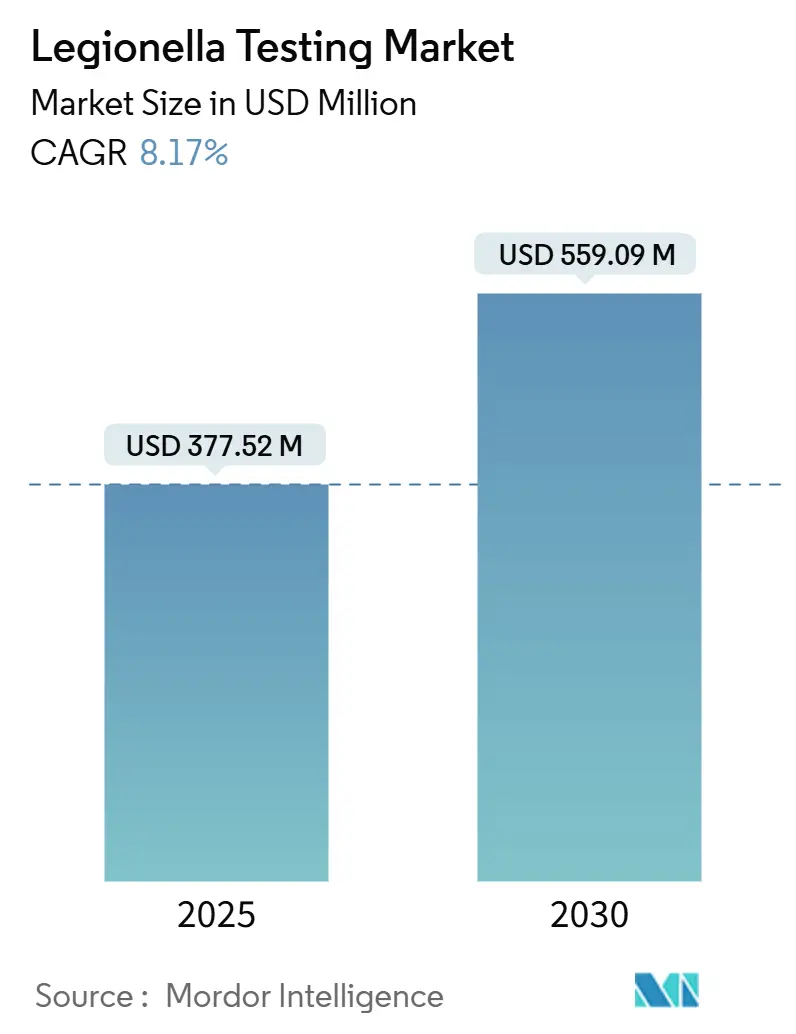
Legionella Testing Market Analysis by Mordor Intelligence
The legionella testing market size was valued at USD 377.52 million in 2025 and is forecast to reach USD 559.09 million by 2030, advancing at an 8.17% CAGR. Stricter building-water regulations, heightened post-pandemic vigilance, and rapid advances in molecular diagnostics are sustaining double-digit demand growth. Mandatory CMS rules that link Medicare funding to implementation of ASHRAE-compliant water management programs keep hospitals and long-term-care facilities on a continuous testing cycle[1]Centers for Medicare & Medicaid Services, “Legionella Water Management Initiative,” cms.gov. Rising legal liability and insurance stipulations have extended this compliance mindset to hotels, commercial real estate, and manufacturing plants. Technology migration toward PCR platforms has shortened result turnaround from 7–14 days to under 48 hours, enabling early intervention protocols that limit outbreak scale.
Key Report Takeaways
- By test type, PCR/qPCR/ddPCR held 42.76% of Legionella testing market share in 2024, whereas urinary antigen tests are projected to grow at a 10.56% CAGR through 2030.
- By end user, hospitals and clinics controlled 49.65% revenue in 2024; diagnostic laboratories lead growth at an 11.56% CAGR to 2030.
- By geography, North America contributed 43.43% revenue in 2024, while Asia-Pacific is expected to expand at a 9.34% CAGR through 2030.
Global Legionella Testing Market Trends and Insights
Driver Impact Analysis
| Driver | % Impact on CAGR Forecast | Geographic Relevance | Impact Timeline |
|---|---|---|---|
| Rising incidence of pneumonia & Legionella-linked illness | +1.8% | Global urban centers | Medium term (2-4 years) |
| Increasing demand for rapid & advanced diagnostics | +2.1% | North America & Europe; expanding APAC | Short term (≤ 2 years) |
| Technological innovations in molecular & IMS methods | +1.5% | Developed markets worldwide | Long term (≥ 4 years) |
| Stricter building-water regulations & ASHRAE-188 adoption | +2.3% | North America; spreading globally | Medium term (2-4 years) |
| Post-COVID re-occupancy of buildings elevating risk | +1.2% | Global commercial properties | Short term (≤ 2 years) |
| Insurance carriers mandating Legionella risk audits | +0.9% | North America & Europe | Medium term (2-4 years) |
| Source: Mordor Intelligence | |||
Rising Incidence of Pneumonia and Legionella-Linked Illness
Reported U.S. Legionnaires’ disease cases tripled from 2000-2011 and have continued climbing through 2024, a pattern mirrored in several OECD countries. Melbourne’s 2024 outbreak produced 77 cases, 75 hospitalizations, and 2 deaths, underscoring how rapidly contaminated aerosols can infect dense urban populations. With mortality in severe cases ranging from 20-40%, health systems recognize that routine surveillance lowers overall treatment costs. Employers also see productivity savings when preventive testing keeps staff from illness. Consequently, sustained epidemiological pressure is translating into baseline demand for both clinical and environmental testing.
Increasing Demand for Rapid and Advanced Diagnostics
Clinicians seek actionable results within 24 hours; culture’s 7-14-day lag is now viewed as clinically unacceptable for severe pneumonia management. PCR platforms provide same-day answers with 99.95% negative predictive value at clinically relevant thresholds. Post-COVID facility re-openings exposed stagnant pipes that intensified bacterial growth, accelerating adoption of rapid molecular panels. Environmental managers likewise favor quick tests so they can adjust disinfection protocols before bacteria levels cross regulatory limits. The push for turnaround times under 48 hours therefore remains a defining feature of the Legionella testing market.
Technological Innovations in Molecular and IMS Methods
Droplet digital PCR detects very low Legionella concentrations that evade conventional assays, improving early-warning reliability in large plumbing networks. Immunomagnetic separation distinguishes viable from non-viable cells, sharpening risk assessments when biocides create cellular debris that would otherwise yield false positives[2]Frontiers in Microbiology, “Advances in Immunomagnetic Separation for Legionella Detection,” frontiersin.org. LAMP paired with lateral-flow strips now delivers field-deployable results in 75 minutes, expanding testing to cooling towers and fountains without lab infrastructure. AI-driven image analytics and automated sample preparation further cut technician time and error rates. Collectively, such innovations enhance sensitivity while lowering per-sample hands-on time.
Stricter Building-Water Regulations and ASHRAE-188 Adoption
ASHRAE-188 turned voluntary guidelines into enforceable codes, reaching more than 5 million U.S. buildings by 2025. The 2024 release of ANSI/ASHRAE-514 imposed facility-wide hazard analyses for hospital water, making quarterly Legionella testing routine. European Union member states have started aligning risk-assessment rules with these U.S. precedents. Insurance underwriters now factor Legionella compliance into premiums, further incentivizing program adoption. The result is a predictable, recurring revenue stream for qualified testing providers.
Restraints Impact Analysis
| Restraints Impact Analysis | (~) % Impact on CAGR Forecast | Geographic Relevance | Impact Timeline |
|---|---|---|---|
| Sub-optimal sensitivity/specificity of legacy tests | -1.4% | Global cost-sensitive markets | Medium term (2-4 years) |
| High cost of PCR/qPCR & ddPCR panels | -2.1% | Emerging markets; smaller facilities | Short term (≤ 2 years) |
| Fragmented global compliance standards increase burden | -1.3% | Global | Medium term (2-4 years) |
| Litigation risk from PCR false positives hindering uptake | -1.0% | North America & Europe | Short term (≤ 2 years) |
| Source: Mordor Intelligence | |||
Sub-Optimal Sensitivity and Specificity of Legacy Tests
Culture yields 70-90% sensitivity depending on sample type and requires repeat sampling when non-Legionella flora overgrow plates. Urinary antigen assays detect only L. pneumophila serogroup 1, missing the 8-30% of cases caused by other serogroups. Each missed detection invites continued exposure and potential litigation, yet budget-limited facilities still opt for these older methods. Widespread reliance on legacy tests therefore slows universal migration to faster, broader-spectrum diagnostics.
High Cost of PCR/qPCR and ddPCR Panels
PCR workstations cost USD 50,000–200,000 and reagents run USD 15–50 per test; culture plates cost USD 5–15. Budget-constrained hospitals and small labs often postpone molecular upgrades despite recognized performance gains. Quality-assurance protocols, personnel training, and maintenance contracts add hidden expenses. Reimbursement gaps in several national health systems leave providers bearing most of the incremental cost, limiting uptake in emerging economies and rural areas.
Segment Analysis
By Test Type: Rapid PCR Drives Molecular Shift
PCR/qPCR/ddPCR platforms captured 42.76% Legionella testing market share in 2024 because hospitals value 24-hour turnaround when treating severe pneumonia. Within the USD 377.52 million Legionella testing market size logged in 2025, PCR assays generated the largest revenue slice by combining high sensitivity with broad serotype coverage. Laboratories also rely on molecular methods to validate water treatment efficacy faster than culture. Culture remains essential for viability confirmation and antimicrobial susceptibility, but its use is shifting toward confirmatory rather than frontline testing. Direct fluorescent antibody staining fills immediate visualization niches yet accounts for a modest revenue contribution. Urinary antigen tests lead growth at a 10.56% CAGR by offering 15-minute point-of-care results that support emergency-department triage decisions. Technology refinements have pushed UAT sensitivity past 95%, and multiplex versions now detect several Legionella species in a single cartridge. As reagent costs fall, UAT kits are penetrating occupational health programs and cruise-ship medical units. Market participants therefore maintain balanced portfolios that cover both rapid molecular and decentralized antigen formats to maximize reach across diverse end-user budgets.
Second-generation ddPCR instruments are expected to erode culture share further by identifying sub-detectable colony counts in large plumbing systems. Field technicians equipped with portable LAMP-lateral-flow kits can now screen spa water during routine maintenance visits, creating new revenue lines for HVAC and water-treatment contractors. Although reagent pricing remains higher than agar media, volume purchasing and reagent rental contracts are narrowing the gap, especially for regional reference labs processing thousands of samples weekly. Over the forecast period, technology convergence will likely see labs combine ddPCR quantification with culture confirmation in a single workflow, cementing molecular dominance across the Legionella testing market.
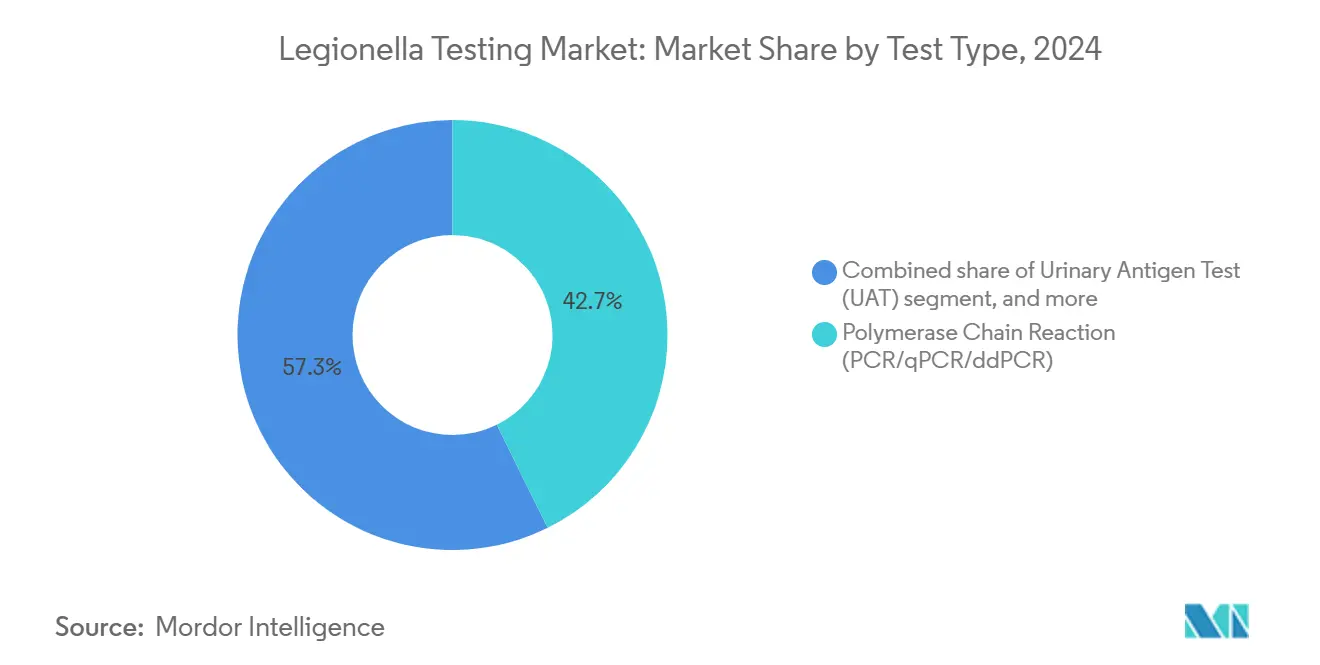
Note: Segment shares of all individual segments available upon report purchase
By End User: Compliance Culture Sustains Laboratory Outsourcing
Hospitals and clinics accounted for 49.65% revenue in 2024, reflecting CMS mandates that tie funding to ASHRAE-aligned water management. Facilities employ a layered strategy of routine water sampling, high-risk patient screening, and post-remediation confirmation to minimize liability. Constant construction, aging piping, and immunocompromised wards amplify testing frequency inside acute-care environments, locking in a large share of recurring demand. Nevertheless, many community hospitals outsource work to commercial reference labs rather than investing in on-site molecular instruments. That shift pushes diagnostic laboratories toward the fastest growth trajectory at an 11.56% CAGR through 2030.
National and regional lab chains leverage economies of scale, ISO 17025 accreditation, and courier networks to deliver two-day water-sample results at predictable prices. Bundled service contracts now combine Legionella testing with chemical parameter monitoring, giving property managers a single compliance partner. Outside healthcare, industrial facilities, hotels, and universities represent untapped potential as insurers and local codes impose more stringent control plans. Over the forecast horizon, integrated lab-plus-field sampling services are expected to attract smaller building operators unable to maintain dedicated water-safety staff, extending the Legionella testing market footprint into new verticals.
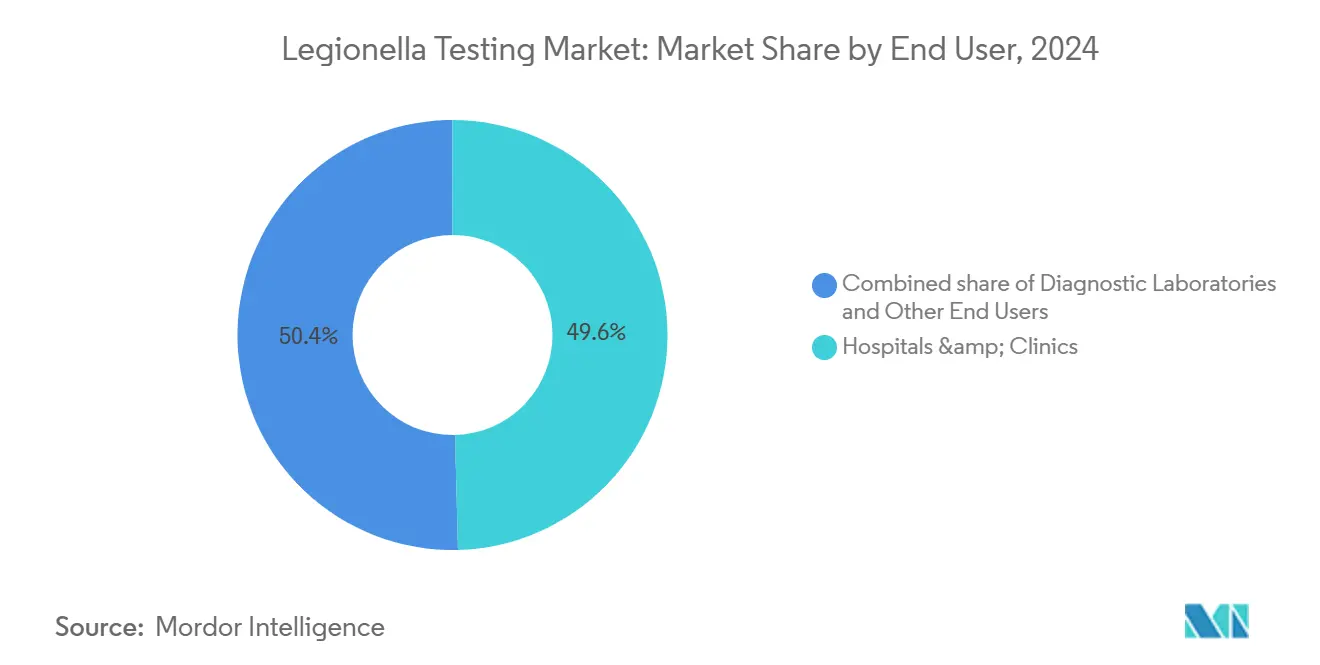
Note: Segment shares of all individual segments available upon report purchase
Geography Analysis
North America generated 43.43% of global revenue in 2024, underpinned by a robust regulatory network that spans CMS rules for healthcare, OSHA guidelines for workplaces, and insurer-driven audits for commercial property owners. Large diagnostic firms headquartered in the United States supply most PCR reagents, while hundreds of accredited laboratories offer same-day test logistics. Canada’s public-health agencies have mirrored U.S. standards, and Mexico’s private hospital expansions are aligning procurement policies accordingly. High litigation exposure also keeps routine testing budgets intact, even during broader healthcare cost pressures.
Asia-Pacific is the fastest-growing region at a 9.34% CAGR, propelled by urbanization and infrastructure investment. Japan’s Expo 2025 detected Legionella counts 50-times above safety limits, prompting nationwide awareness campaigns and stricter municipal codes. China’s hospital-building boom and India’s PPP hospital projects necessitate comprehensive water-safety plans that incorporate quarterly testing. Hong Kong’s cooling-tower surveillance, which analyzed 115 samples in July 2024 alone, showcases government-led vigilance[3]Electrical and Mechanical Services Department, “Monthly Cooling Tower Surveillance Report,” emsd.gov.hk. Australia’s state health departments continue to enforce monthly cooling-tower checks, setting a compliance example for Southeast Asian neighbors.
Europe presents a fragmented picture shaped by differing national laws and energy-conservation goals. Germany’s high legionellosis incidence has moved laboratories toward the IDEXX Legiolert method, regarded as more sensitive than ISO plates. France continues to subsidize UAT kits for nursing homes, whereas the United Kingdom mandates quarterly risk assessments under HSE guidance. Green-building initiatives sometimes reduce hot-water storage temperatures, requiring sophisticated control strategies that maintain energy efficiency without fostering bacterial growth. Testing providers capable of navigating multiple regulatory frameworks enjoy a competitive edge across the European Union.
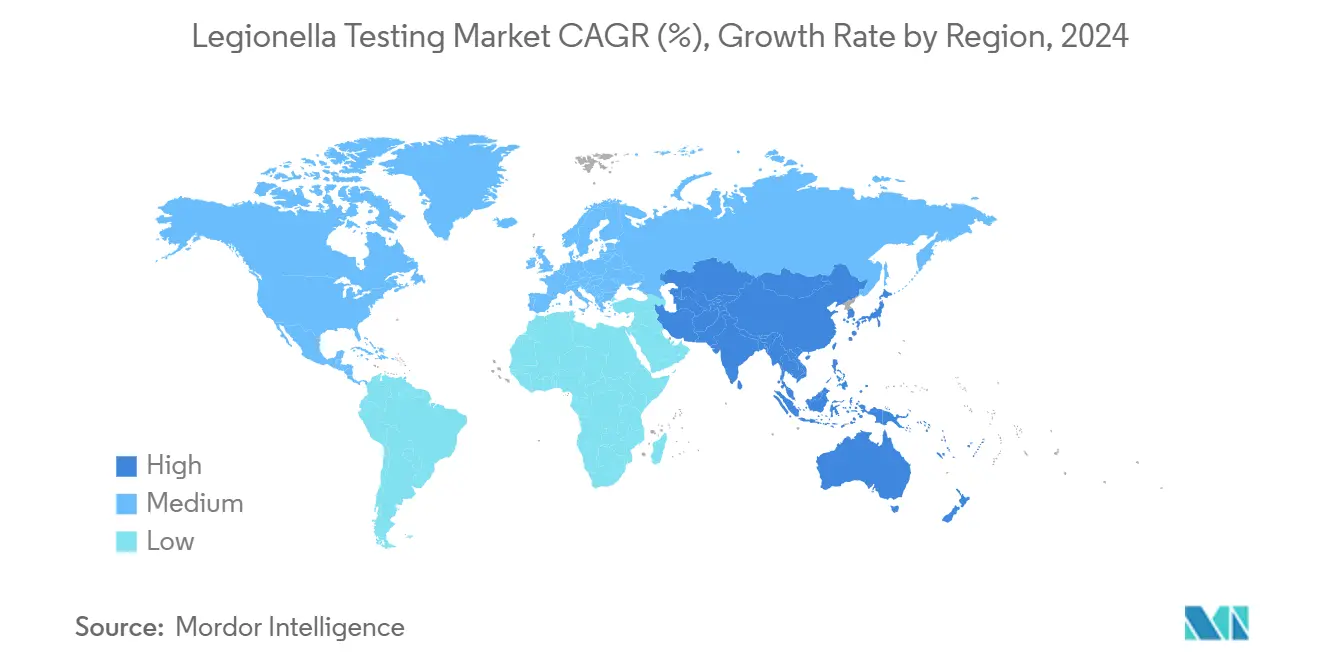
Competitive Landscape
The legionella testing market shows moderate fragmentation, with molecular-biology multinationals competing alongside niche water-safety specialists. bioMérieux, Thermo Fisher Scientific, and Qiagen exploit broad reagent catalogs and automated PCR platforms to serve hospital laboratories worldwide. IDEXX Laboratories targets environmental customers with the Legiolert method, while Phigenics sells combined consulting and testing packages that help property owners draft ASHRAE-compliant plans. Market rivalry is increasingly technology-centric: companies race to launch faster assays, cloud-based data dashboards, and automated sampling robots that collect pipe biofilm without technician exposure.
Vertical integration is gaining momentum. Ecolab’s November 2024 purchase of Barclay Water Management added proprietary iChlor monochloramine systems to its testing services, positioning the firm as a one-stop water-safety supplier. Similar moves are expected as treatment firms acquire diagnostics players to secure recurring reagent revenue. Start-ups are also active, offering smartphone-linked biosensors that push real-time alerts to building managers. Large diagnostic houses respond by embedding AI-powered interpretation into instrument software, reducing the skill threshold for lab operators.
Price competition remains muted for premium molecular tests, where intellectual-property protection and regulatory approvals create entry barriers. In contrast, commoditized culture media see tighter margins, prompting vendors to bundle consumables with technical support. Regional laboratories differentiate through ISO accreditation, fast courier pick-ups, and customizable reporting formats that feed data directly into client compliance dashboards. Over the forecast period, laboratories that pair high-throughput ddPCR capacity with consulting services are likely to consolidate share, especially in regions adopting stringent water-management legislation.
Legionella Testing Industry Leaders
-
Thermo Fisher Scientific Inc.
-
BioMérieux SA
-
Becton, Dickinson and Company
-
Aquacert Ltd
-
Qiagen NV
- *Disclaimer: Major Players sorted in no particular order
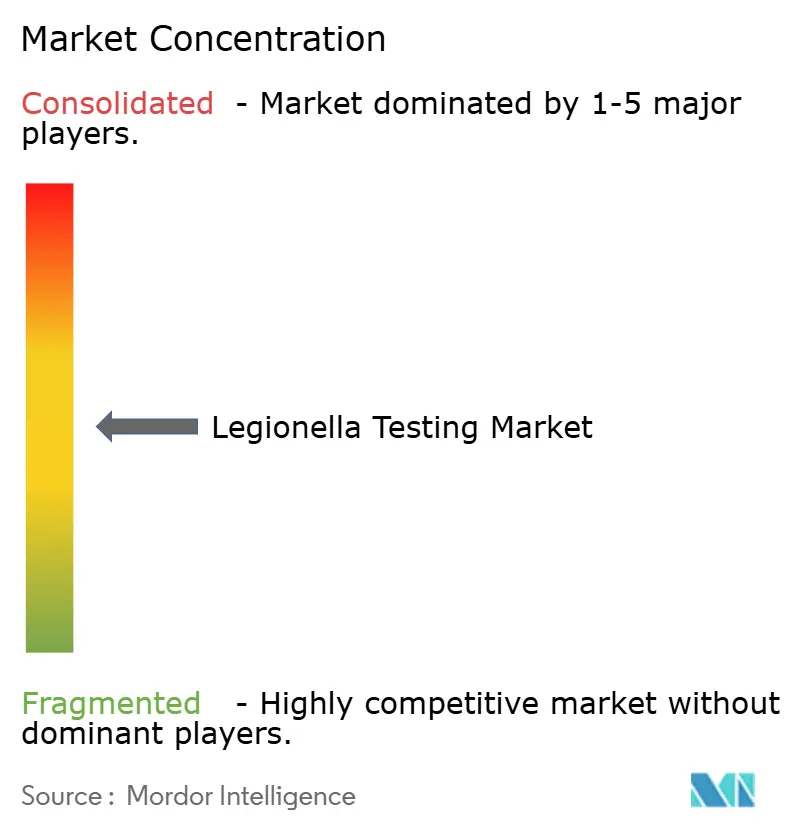


Recent Industry Developments
- November 2024: Ecolab acquired Barclay Water Management, adding continuous digital monitoring and monochloramine generation technology to its water-safety portfolio.
- June 2024: Aptamer Group partnered with Microsaic Systems to integrate Optimer binders into the Microtox platform for rapid Legionella detection.
- August 2024: Melbourne health officials confirmed two deaths in an outbreak tied to contaminated cooling towers, triggering emergency testing of 54 towers citywide.
- August 2024: Hong Kong’s Electrical and Mechanical Services Department tested 115 cooling-tower samples, identifying seven exceedances and ordering immediate remediation.
Research Methodology Framework and Report Scope
Market Definitions and Key Coverage
Our study defines the legionella testing market as all revenues earned from diagnostic kits, consumables, and laboratory services used to detect Legionella species in clinical or environmental samples worldwide.
Scope Exclusion: Environmental remediation services and sensor-based real-time monitoring devices are outside the current valuation.
Segmentation Overview
- By Test Type
- Culture Method
- Urinary Antigen Test (UAT)
- Direct Fluorescent Antibody (DFA)
- Polymerase Chain Reaction (PCR/qPCR/ddPCR)
- Other Test Types
- By End User
- Hospitals & Clinics
- Diagnostic Laboratories
- Other End Users
- Geography
- North America
- United States
- Canada
- Mexico
- Europe
- Germany
- United Kingdom
- France
- Italy
- Spain
- Rest of Europe
- Asia-Pacific
- China
- Japan
- India
- Australia
- South Korea
- Rest of Asia-Pacific
- Middle East & Africa
- GCC
- South Africa
- Rest of Middle East & Africa
- South America
- Brazil
- Argentina
- Rest of South America
- North America
Detailed Research Methodology and Data Validation
Primary Research
Mordor analysts spoke with infection-control officers, hospital lab managers, municipal water inspectors, and kit makers across North America, Europe, and Asia-Pacific. These conversations validated assumed kit prices, turnaround-time preferences, and forthcoming regulation timetables, allowing us to adjust penetration rates and price curves with confidence.
Desk Research
We began with public health surveillance files from the CDC, ECDC, and WHO, plus national water-quality compliance reports, which helped us size annual test volumes and map outbreak hot spots. Trade bodies such as the Water Quality Association and the American Clinical Laboratory Association provided price benchmarks and laboratory capacity figures, while peer-reviewed articles clarified sensitivity differences among culture, UAT, and PCR methods. Customs statistics from Volza revealed cross-border kit flows that signal unmet demand, and company filings supported by D&B Hoovers anchored supplier revenues.
A follow-up scan of Dow Jones Factiva news, Questel patent abstracts, and regional tender portals captured pipeline launches and bulk-testing contracts. This is where Mordor analysts refine early desk insights before any modeling. The sources named are illustrative; many additional references informed data collection, validation, and clarification.
Market-Sizing & Forecasting
We reconstruct 2025 demand through a top-down prevalence-to-testing cascade. Reported Legionnaires cases are corrected for underdiagnosis, multiplied by recommended clinical and environmental test ratios, and merged with building-water compliance counts. Bottom-up spot checks, namely supplier shipment roll-ups and sampled ASP × volume, help fine-tune totals. Key variables include disease incidence, compliance-test frequency, PCR kit adoption rate, average selling price, laboratory throughput, and regulatory inspection counts. A multivariate regression that links these drivers to market value projects growth to 2030, while scenario analysis captures abrupt rule changes. Any regional data gaps are bridged with validated price-volume proxies.
Data Validation & Update Cycle
We ensure outputs pass variance thresholds, multi-step analyst reviews, and anomaly checks against independent metrics before sign-off. The model refreshes each year, and interim updates follow material events such as product recalls, major outbreaks, or regulation shifts. Before delivery, a final analyst sweep ensures clients receive the most current view.
Why Our Legionella Testing Baseline Commands Reliability
We observe that published figures vary because scope choices, price assumptions, and refresh speed differ among publishers.
Key Gap Drivers: some studies fold in remediation services, others hold average selling prices static, and a few rely on historic ratios without verifying rapid PCR uptake. Differing base years and currency conversions widen the spread.
Benchmark comparison
| Market Size | Anonymized source | Primary gap driver |
|---|---|---|
| USD 377.52 M (2025) | Mordor Intelligence | |
| USD 346.8 M (2024) | Global Consultancy A | Excludes compliance-water testing and applies a flat culture-test price |
| USD 296.0 M (2022) | Industry Association B | Earlier base year and no adjustment for PCR penetration growth |
| USD 343.2 M (2024) | Trade Journal C | Bundles sensor device sales and offers limited regional breakout |
These comparisons show that our disciplined scope, current-year anchoring, and continuous validation make Mordor's baseline the dependable starting point for strategic decisions.


Key Questions Answered in the Report
What is the current size of the Legionella testing market?
The Legionella testing market was valued at USD 377.52 million in 2025 and is projected to grow at an 8.17% CAGR to 2030.
Which test method generates the largest revenue?
PCR-based molecular diagnostics hold 42.76% Legionella testing market share because they deliver results within 24-48 hours.
Which region is expanding fastest?
Asia-Pacific is forecast to grow at a 9.34% CAGR through 2030, driven by new building construction and heightened public-health oversight.
Why are diagnostic laboratories growing so quickly?
Outsourcing by smaller hospitals and commercial properties supports an 11.56% CAGR for specialized laboratories that offer high-throughput molecular testing.
What regulations drive demand in the United States?
CMS requires healthcare facilities to implement ASHRAE-compliant water-management plans, which mandate routine Legionella testing for compliance.
How are technology trends influencing test choices?
Advances such as droplet digital PCR and LAMP-lateral-flow kits are reducing turnaround times and detecting lower bacterial counts, prompting many facilities to upgrade from legacy culture methods.
Page last updated on:
